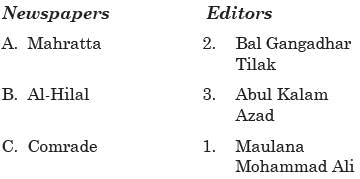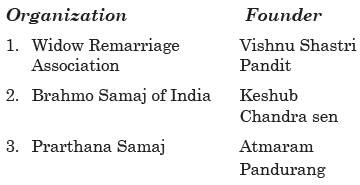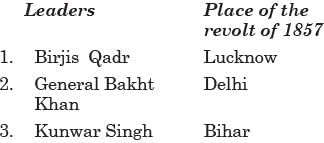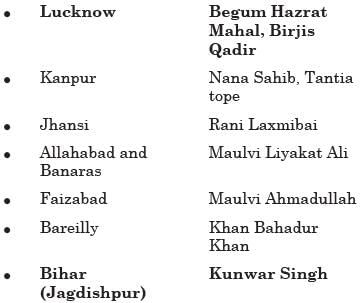Test: History & Culture - 7 - UPSC MCQ
25 Questions MCQ Test - Test: History & Culture - 7
Match the following:
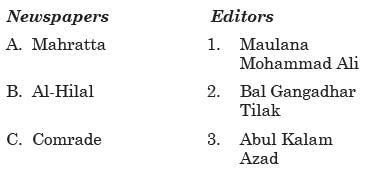
Select the correct answer using the code given below:



Who among the following opposed raising the minimum age of marriage for girls from 10 to 12 years as embodied in the Age of Consent Act, 1891?
Which of the following events gave impetus to the Indian National Movement?
1. World War One.
2. Russian Revolution.
3. Nationalist agitations in Afro-Asia world.
Select the correct answer using the code given below:
1. World War One.
2. Russian Revolution.
3. Nationalist agitations in Afro-Asia world.
Who among the following wrote “Manucharita” which gives a detailed account of the Vijaynagar Empire?
Consider the following statements regarding revolutionary terrorism in British India:
1. The revolutionaries tried to organize a mass revolution after all avenues of peaceful protest were blocked by the British.
2. Prafulla Chaki and Khudiram Bose were involved in an incident of throwing bomb at Viceroy Hardinge.
3. Sandhya and Kal were the prominent newspapers advocating revolutionary terrorism.
Which of the above statements is/are incorrect?
With reference to the Kisan Sabha, Consider the following statements :
1) The All-India Kisan Congress was established in Lucknow in 1936 which later changed its name to All India Kisan Sabha
2) The first session of the Kisan Sabha was held along the Faizpur session of Indian National Congress
3) The Faizpur session of the All-India Kisan Congress presided over by Jawahar Lal Nehru.
Select the correct answers from the code given below :
The Indian National Congress met in a special session at Bombay in August 1918 under the presidentship of _____________ to consider the _____________. Fill in the blanks using the code given below:
Who among the following resigned from their membership of the central legislative council against the passage of Rowlatt Act 1919?
1. Motilal Nehru
2. Mohammad Ali Jinnah
3. Madan Mohan Malviya
4. Abul Kalam Azad
Select the correct answer using the code given below:
What was the reason for Gandhiji to organize a Satyagrah on behalf of the peasants of Kheda?
Consider the following pairs:
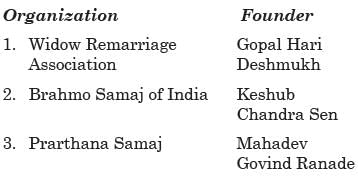
Which of the above-given pairs is/are correctly matched?
Which of the following methods were used by Lord Wellesley for expanding British Empire in India?
1. Subsidiary Alliance
2. Outright wars
3. Assumption of territories of previously subordinated rulers
4. Doctrine of Lapse
Select the correct answer using the code given below:
Which among the following events-related to Rammohan Roy happened earliest?
Consider the following statements regarding the Champaran Satyagraha:
1. This was Gandhi’s first civil disobedience struggle in India.
2. It was fought against the rising commercialization of cotton crops.
Which of the above statements is/are correct?
Which of the following constituted the NonCooperation Movement?
1. Surrender of government titles.
2. Boycott of schools, courts, and councils.
3. Boycott of foreign goods.
4. Promotion of arbitration courts.
Select the correct answer using the code given below:
Which of the following were the reasons for the popular discontent that led to the revolt of 1857?
1. Economic exploitation by the Britishers
2. Destruction of the traditional economic fabric
3. Land revenue policies
4. The disappearance of Indian states
5. Activities of Christian missionaries
Select the correct answer using the code given below:
Which of the following were the reasons of Stagnation and Deterioration of Agriculture under British Rule?
1. Overcrowding of agriculture
2. Excessive land revenue demand
3. Growth of landlordism
4. Increasing indebtedness
Select the correct answer using the code given below:
Which of the following events related to the Non-Cooperation Movement happened earliest?
Lord Cornwallis brought into existence the civil service in India. Which of the following were the reforms undertaken by him to ensure the efficiency of civil services in India?
1. Ban on private trade and acceptance of presents and bribes by officials.
2. Setting up college of Fort William for education of young recruits to the services.
3. Promotion based on seniority.
4. Rigid and complete exclusion of Indians from service.
Select the correct answer using the code given below:
Which of the following statements are incorrect regarding Civil Disobedience Movement?
1. It was started with Dandi March by Mahatma Gandhi on 12th March, 1930.
2. North-East India remained unaffected by this movement.
3. In the north-west the most famous leader was Abdul Gaffar Khan, nick-named as “Frontier Gandhi”.
4. During it, the Maratha soldiers refused to fire on the unarmed crowd at Peshawar.
Select the correct answer using the code given below:
Consider the following pairs:

Select the correct answer using the code given below:
Arrange the following organisations Predecessors of the Indian National Congress in chronological order:
1. Madras Native Association
2. Bombay Presidency Association
3. East India Association
4. Bengal British Indian Society
Select the correct answer using the code given below:
Which of the following statements regarding Morley-Minto Reforms is/are correct?
1. All the elected members of Imperial Legislative Council were elected directly by the provincial council.
2. It introduced an element of direct elections for the first time.
3. It introduced separate electorate for depressed classes.
Select the correct answer using the code given below:
Who among the following said that “the fight that was commenced in 1920 is a fight to the finish, whether it lasts one month or one year or many months or many years?”
Consider the following statements regarding the revolt of 1857:
1. There was a clear vision of creating a republican state after the revolt of 1857.
2. It was highly inspired by the idea of modern nationalism.
Which of the statements given above is/are incorrect?


